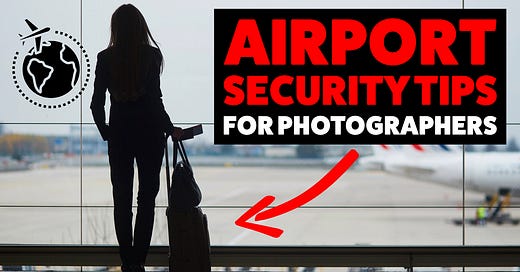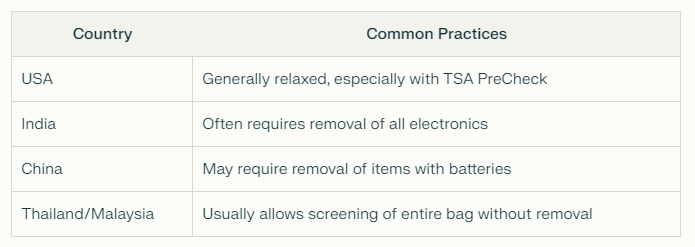Airport Security Tips for Photographers
Traveling with your camera equipment can be a nerve-wracking experience.
In particular when it comes to airport security.
Many photographers worry about their gear being mishandled or damaged during the screening process.
But with the right approach, you can make your journey through airport security smoother and less stressful.
Understanding Airport Security Procedures
Security procedures can vary depending on the airport and country you're traveling through.
Most locations require you to remove all electronic devices from your bag.
But some still allow you to keep your gear packed.
So it's important to be prepared for different scenarios.
According to a 2023 study by the International Air Transport Association (IATA), 65% of travelers find removing electronics from bags to be one of the most stressful aspects of airport security.
Tips for a Smooth Security Experience
1. Be Proactive
Take the initiative to remove your camera and any items with batteries from your bag before reaching the security checkpoint.
This approach prevents security personnel from handling your equipment and allows you to maintain control over your gear.
2. Pack Strategically
Organize your gear in a way that makes it easy to remove and replace items quickly.
Use separate pouches for cables and batteries to speed up the process if you need to remove them.
You can use a small one like the Peak Design Tech Pouch.
It’s a versatile organizer and perfect for keeping your cables, batteries, and small accessories neatly arranged.
Travel photographer Elia Locardi advises:
"I use clear, zippered pouches for my cables and batteries. This not only keeps everything organized but also allows security personnel to see the contents without having to open each pouch".
For more tips on organizing your gear, check out my guide on camera gear storage and protection.
3. Consider TSA PreCheck
If you frequently travel within the United States, investing in TSA PreCheck can reduce hassles at security.
PreCheck members often don't need to remove electronics from their bags.
This makes the process much smoother.
According to the Transportation Security Administration (TSA), in March 2024, 95% of TSA PreCheck passengers waited less than 5 minutes in security lines.
4. Be Prepared to Explain
Some security agents may not be familiar with specialized photography equipment.
Be ready to explain what your gear is and how it functions if asked.
This is especially important if you're traveling with specialized equipment like drones.
Dealing with Different Countries
Security procedures can vary significantly between countries:
A 2023 survey by the World Travel & Tourism Council found that 72% of travelers experienced different security procedures across countries.
This shows the importance of researching destination-specific requirements.
For more insights on traveling with camera gear, check out my travel photography tips.
When Extra Scrutiny is Required
If your bag is selected for additional screening, remain calm and cooperative.
Most security agents will allow you to handle your own equipment if you offer to do so.
This ensures your gear is handled carefully and gives you peace of mind.
Packing Tips for X-Ray Screening
To minimize the chances of your bag being flagged for additional screening:
Arrange your gear in a single layer when possible.
Avoid stacking items on top of each other.
Position your camera and lenses so they're easily identifiable from a top-down view.
Cases like the Pelican 1535 Air Carry-On are designed for easy X-ray screening and offer excellent protection for your gear.
Professional photographer Trey Ratcliff suggests:
"I always pack my camera bag as if it's going to be x-rayed. This means spreading out the gear and avoiding dense clusters of metal objects".
Traveling with Film
If you're carrying film, especially high-speed film (ISO 800 or higher), request a hand check.
X-ray machines can potentially damage film, particularly if it passes through multiple times.
A 2022 study by Kodak found that up to 30% of high-speed film can be affected by a single pass through modern airport x-ray machines.
The Domke 711-15B Film Guard Bag is ideal for this usage.
It helps protect your film from X-ray damage.
For more on film photography, check out my guide on film photography mistakes beginners make.
Dealing with Drones
Drone regulations vary widely between countries.
Research the rules of your destination before traveling.
Some countries may require you to declare your drone upon entry or even prohibit it entirely.
Insurance Considerations
Consider purchasing travel insurance that covers your camera gear.
While it won't prevent damage, it can provide peace of mind and financial protection in case of accidents or theft during your journey.
A 2023 survey by the Travel Insurance Review found that 68% of professional photographers always purchase additional insurance when traveling with their gear.
Minimizing Gear for Travel
If security concerns are a major issue, consider traveling with a minimalist kit.
A compact camera or a mirrorless system with one or two versatile lenses can still produce excellent results while reducing security hassles.
Travel photographer Erin Sullivan notes:
"I've found that a mirrorless camera with a 24-70mm lens covers most of my needs while traveling. It's a great compromise between quality and portability".
For recommendations on compact cameras, check out my guide on compact point-and-shoot cameras.
And That’s It
Make sure to arrive at the airport with plenty of time to spare, especially if you're carrying a lot of gear.
With the right approach, you can protect your equipment and start your photography adventure stress-free.
Happy travels!
‘Hakan.




